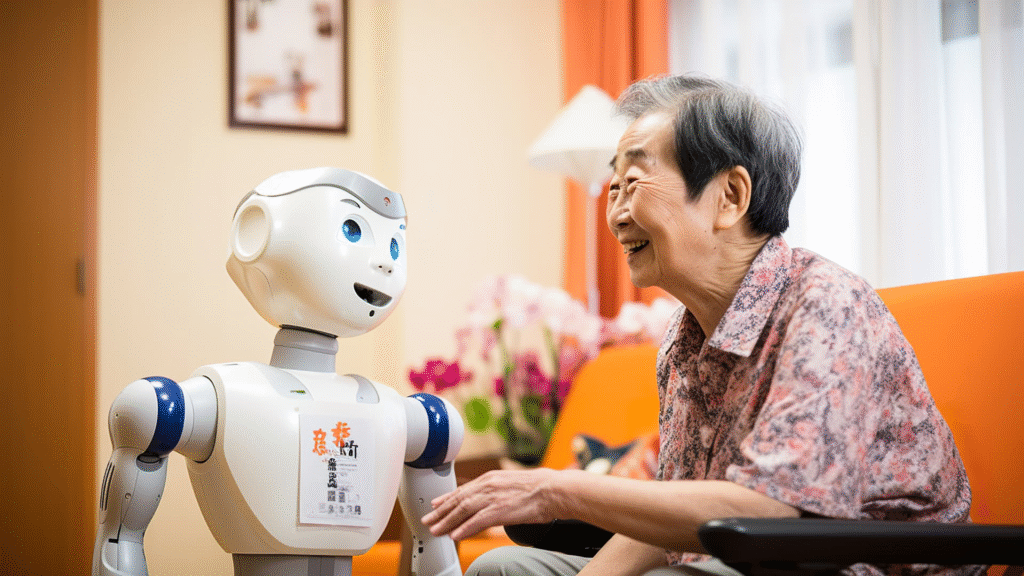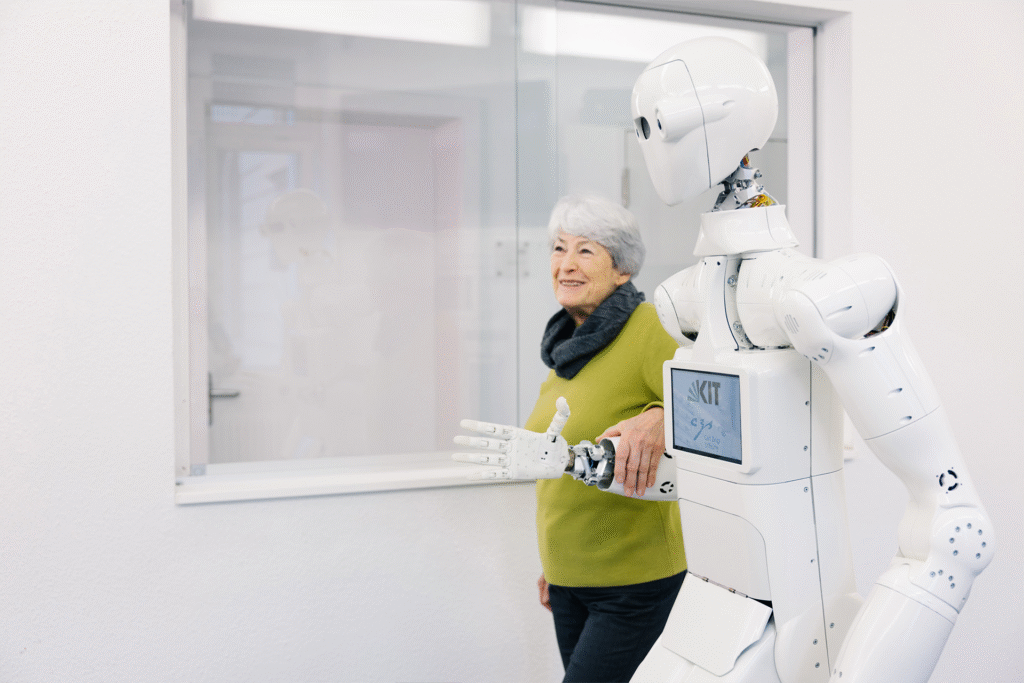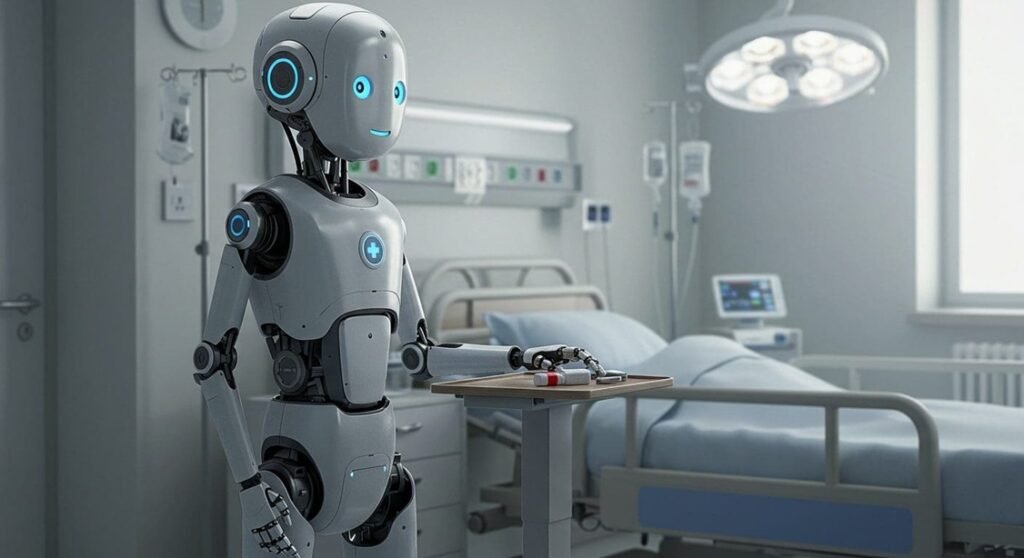In a world where the population is aging at an unprecedented pace, the need for innovative solutions to support the elderly is more crucial than ever. According to the World Health Organization, by 2050, the number of people aged 60 years and older will double, reaching over 2 billion. Amid this demographic shift, MIT’s latest technological marvel—the E-BAR (Elderly Bodily Assistance Robot)—is poised to revolutionize how we care for the elderly, offering a new era of safety, independence, E-BAR Robot: and dignity.

What Is the E-BAR Robot?
The E-BAR Robot, developed by researchers at the Massachusetts Institute of Technology (MIT), is a state-of-the-art robotic assistant designed specifically to aid elderly individuals with mobility challenges. E-BAR stands out due to its intelligent design and dual functionality. It not only assists seniors in sitting and standing—often the most strenuous and risky parts of their daily routine—but it also has the ability to catch them if they fall, a feature that significantly enhances safety in home E-BAR Robot: and care facility settings.
At its core, E-BAR is an empathetic machine, one that understands the frailty of aging bodies and provides support without robbing the user of autonomy. It bridges the gap between needing full-time human care and living independently, offering a balance that many E-BAR Robot: aging adults seek.
The Growing Need for Assistive Technology
Before diving deeper into E-BAR’s features, it’s important to understand the broader context. Falls are a leading cause of injury and death among older adults. In the United States alone, one out of every four seniors falls each year, and falls are responsible for over 34,000 deaths annually. Most of these incidents occur at home and during mundane tasks such as sitting down, getting out of bed, E-BAR Robot: or standing up from a chair.
Traditional methods of fall prevention—like grab bars and walking aids—are helpful but often inadequate. In many cases, elderly individuals feel embarrassed or reluctant to rely on such tools, which can impact their mental health and sense of independence.
E-BAR aims to eliminate this stigma by being more than a static aid; it’s an interactive, responsive, E-BAR Robot: and intelligent assistant designed with human-centric empathy.
How E-BAR Works: Engineering Meets Empathy
The E-BAR Robot is equipped with advanced sensors, AI-powered motion tracking, and real-time feedback mechanisms that work together to respond to a user’s body language E-BAR Robot: and movements. Here’s a closer look at how it functions:
1. Sitting and Standing Assistance
E-BAR utilizes motorized arms and soft, ergonomic grips to provide gentle support when the user wants to sit down or stand up. Unlike rigid bars or frames, E-BAR adjusts its position dynamically based on the user’s height, weight, and body posture, reducing the physical strain on muscles E-BAR Robot: and joints.
2. Real-Time Fall Detection and Prevention
What truly sets E-BAR apart is its real-time fall detection and intervention system. Using a combination of computer vision and machine learning, E-BAR can predict a potential fall milliseconds before it happens. When it detects instability, it rapidly engages its mechanical arms to support the E-BAR Robot: user—either by bracing them or gently easing them to the ground to avoid injury.
3. Voice and Gesture Commands
E-BAR responds to both voice and simple hand gestures. This means elderly users do not need to press buttons or navigate complex menus. For example, raising a hand might signal the robot to approach, while a verbal command like “Help me stand” would trigger the standing assist feature.
4. Compact and Mobile Design
Despite its powerful features, E-BAR is compact and designed for in-home use. Its wheels allow for smooth mobility across different floor surfaces, and it can even follow users around the home if needed. It can dock itself for charging and can be scheduled to operate during specific hours of the day.
The Technology Behind E-BAR
The success of E-BAR lies in the seamless integration of robotics, artificial intelligence, and biomechanics. The robot’s AI engine has been trained on thousands of motion scenarios to accurately detect irregularities that might precede a fall. Reinforcement learning algorithms enable it to improve over time, personalizing its responses to each user.
Additionally, E-BAR features:
- LIDAR and depth cameras for spatial awareness.
- Gyroscopic sensors to measure the user’s balance and orientation.
- Pressure-sensitive grips to ensure a safe yet gentle touch.
- Edge computing modules for processing data locally, minimizing latency.
This blend of cutting-edge components enables E-BAR to act almost like a physical therapist, assistant, and guardian—all rolled into one.
E-BAR vs Traditional Assistive Devices
Traditional devices like walkers, wheelchairs, or lift chairs offer mechanical support but lack intelligence. E-BAR, by contrast, adapts in real-time and anticipates needs rather than merely reacting to them. Here’s a comparative snapshot:
| Feature | Traditional Device | E-BAR Robot |
| Static Support | Yes | No |
| Fall Detection | No | Yes |
| Adaptive Assistance | No | Yes |
| Voice/Gesture Commands | No | Yes |
| Smart Home Integration | Rare | Planned Feature |
| Personalized Learning | No | Yes |
E-BAR does not aim to replace human caregivers but rather augment their ability to offer consistent and safe support.
Real-Life Applications and Success Stories
Initial pilot programs conducted at eldercare facilities and individual homes have shown promising results. In a six-month trial at a senior living community in Boston, residents reported a 47% reduction in fall-related incidents. More importantly, participants expressed a heightened sense of security E-BAR Robot: and independence.
Margaret Hill, an 82-year-old retired teacher, described her experience: “Before E-BAR, I was always nervous about moving around alone. Now, I feel like someone is always watching out for me—but in a good way.”
Caregivers also noted a reduction in physical strain and stress, allowing them to focus more on emotional and social care.

Challenges and Ethical Considerations
As with any AI-driven technology, E-BAR raises important ethical and logistical questions:
- Privacy: How will user data—especially motion patterns and voice recordings—be stored and protected?
- Dependence: Could over-reliance on E-BAR lead to reduced physical activity or social interaction?
- Accessibility: Will the robot be affordable and available to the general population, or only to affluent segments?
MIT has addressed some of these concerns by ensuring that all data is encrypted and processed locally. Additionally, they are working with nonprofit organizations to make E-BAR accessible in underfunded eldercare institutions.
Future Developments and Roadmap
MIT’s engineering team views E-BAR as just the beginning. Future updates may include:
- Integration with smart home ecosystems (e.g., Alexa, Google Home).
- Health monitoring tools like heart rate and oxygen level sensors.
- Remote caregiver connectivity, enabling real-time alerts and video check-ins.
- Emotional recognition AI, which could detect signs of loneliness or depression.
The long-term vision is for E-BAR to become a holistic health companion, providing not only physical support but also contributing to the mental and emotional well-being of elderly users.
Global Impact and Market Potential
The assistive robotics market is projected to grow to over $10 billion by 2030. E-BAR, with its pioneering features and reputable backing by MIT, is well-positioned to lead this market. Countries with aging populations such as Japan, Germany, and the United States could particularly benefit from such innovations.
Governments and healthcare providers are already showing interest, E-BAR Robot: and pilot programs are expanding to Canada, the UK, and parts of Scandinavia.
Conclusion: A Compassionate Future with Technology
The E-BAR Robot is more than just a machine—it’s a symbol of how technology, when designed thoughtfully, can enhance human dignity and quality of life. In a world that often struggles to keep up with the needs of an aging population, innovations like E-BAR provide a hopeful glimpse into a more compassionate, tech-enabled future.
By empowering the elderly to live safer, more independent lives, E-BAR not only reduces the burden on caregivers and healthcare systems but also redefines what aging with grace and autonomy looks like in the 21st century.
As MIT continues to refine and expand the capabilities of E-BAR, we stand at the threshold of a new age—one where robots don’t replace human touch, but rather extend it with precision, patience, and empathy.
Read more https://magazinesnove.com/india-pakistan-military-talks-noon-today-key/


